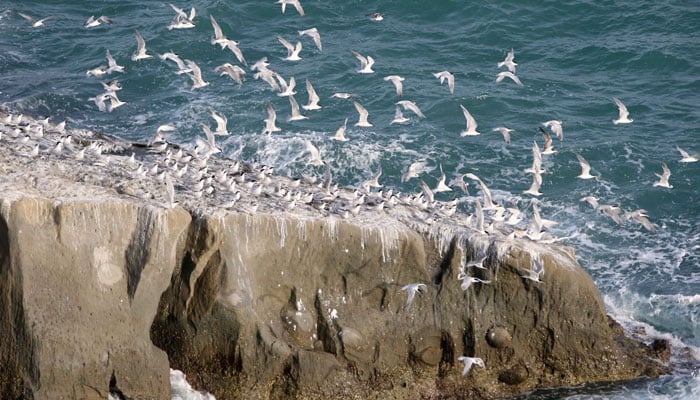Pakistan's first marine protected area: Balochistan govt officially endorses management plan of Astola Island
Under AIMPA, activities like harming endangered marine life, building structures among others are strictly prohibited
April 20, 2025

Almost eight years after it was designated as Pakistan’s first marine protected area (MPA) in June 2017, Astola Island, also known as Jezira Haft Talar (Island of the Seven Hills), now has an officially endorsed management plan by the Balochistan government, known as the Astola Island Marine Protected Area (AIMPA).
The Government of Pakistan is a signatory to the United Nations Convention on Biological Diversity. At the 1992 Rio Earth Summit, 150 countries signed the CBD, which promotes the conservation of various forms of life on the planet and the equitable use of living resources.
Under the convention, many states formulated their first-generation Biodiversity Action Plans, and Pakistan’s was made in 1999. These national action plans were to be achieved by 2010.
However, the Global Biodiversity Outlook 3 (GBO3), a publication of the CBD since 2010, stated that the 2010 targets were not met globally. In 2010, at the 10th Conference of the Parties (COP) to the CBD, held in Aichi Prefecture, Japan, the Strategic Plan for Biodiversity 2011-2020 was adopted. This plan stipulated the Aichi Biodiversity Targets (ABTs), which included five strategic goals, each covering 20 sub-targets. These goals were to be achieved by 2020.
The COP15 to the CBD, held in 2022, formed the Kunming-Montreal Global Biodiversity Framework (KMGBF). The framework envisions a world in harmony with nature where “by 2050, biodiversity is valued, conserved, restored and wisely used, maintaining ecosystem services, sustaining a healthy planet and delivering benefits essential for all people.” For this, the framework has four goals to be achieved by 2050 and 23 action-oriented global targets to be achieved by 2030.
Under the KMGBF, Target 3: Conserve Land, Water and Seas aims to ensure that “by 2030 at least 30 per cent of terrestrial and inland water areas, and of marine and coastal areas, especially areas of particular importance for biodiversity and ecosystem functions and services, are effectively conserved and managed”.
Since Pakistan is a signatory to this convention, it has to achieve this target. Pakistan’s international commitments to climate change and the environment fall under the Federal Ministry of Climate Change and Environmental Protection. Government-managed protected areas in the country are the responsibility of the provincial governments.
By notifying MPAs and then implementing their management plan, Pakistan makes an essential contribution to achieving the 2030 global target. Pakistan has identified several potential MPA sites in Balochistan and Sindh provinces. Astola Island MPA was the first marine protected area (MPA) to be designated in Pakistan, on June 15, 2017.
According to the management plan document, Astola Island encompasses terrestrial, intertidal, and marine habitats and biodiversity, making it both nationally and internationally significant. “There are no coral reefs in Pakistan, but an early stage of reef formation has been reported from Astola, and 11 species of hard corals were identified during the 2018 baseline survey, including five vulnerable or near threatened (NT) species,” said the report.
The report said that Astola Island has one of the most important nesting beaches for green turtles, which is classified as endangered by the International Union for Conservation of Nature (IUCN). Astola Island is home to a special snake called the saw-scaled viper that’s found nowhere else in the world. Also, the first time scientists saw sea anemones and a colourful fish called Gardiner’s butterflyfish in Pakistan was around Astola Island.
Under the AIMPA, activities like harming endangered marine life, fishing with explosives or chemicals, building structures, staying without permission, and using firearms (except by law enforcement) are strictly prohibited. Recreational activities such as scuba diving, jet skiing, and sport fishing also require prior approval. Any action that disturbs the ecosystem or affects breeding and feeding areas is prohibited. Permissions are granted only if they are in alignment with the CBD.
According to a press statement from the IUNC Pakistan, after months of dedicated efforts, from ground-level interventions to inclusive consultations, the Balochistan government has officially endorsed the management plan for Astola Island.
The Federal Ministry for Climate Change formed the National Coordinating Body (NCB) to facilitate the KMGBF 30x30 targets, which led to Astola Island’s designation as an MPA. The NCB then identified management gaps and requested IUCN Pakistan to develop a comprehensive management plan for the island.
Convened by the IUCN, the 3rd Subcommittee Meeting on MPAs, held during the 24th NCB Meeting (co-hosted by the Engro Foundation), advanced the AIMPA into its implementation phase. “This move contributes directly to Pakistan’s commitments under the CBD 30x30 target, the ABT, and the KMGBF,” the IUCN press release said.
The IUCN classifies protected areas, including MPAs, into six categories based on their management objectives. Astola Island MPA is a Category IV site, which is a habitat or species management area. The objective under this category is to protect species or habitats, where management reflects this priority. A Category IV protected area may require regular, active interventions to meet the needs of particular species or habitats, and this is expected to be an important management requirement for Astola Island MPA.
The Federal Secretary, Ministry of Climate Change & Environmental Coordination (MoCC&EC), Aisha Humera Chaudhary, said that the NCB has proven to be a vital platform for driving Pakistan’s marine conservation agenda. The endorsement of the Astola Island Management Plan is a national breakthrough.
The Secretary, Forest & Wildlife Department, Government of Balochistan, Abdul Fattah Bhangar, said that the Balochistan government stands fully committed to implementing the endorsed MPA. “We are determined to ensure its success in line with global biodiversity frameworks and through the active support of our partners. This is a national achievement made possible through IUCN’s technical leadership and the collaborative effort of all stakeholders.”
Country Representative IUCN Pakistan Mahmood Akhtar Cheema highlighted the urgent need to move from planning to implementation, given the mounting pressures on Pakistan’s marine and coastal resources from climate change and human-induced impacts. During his address, he emphasised that sustained engagement through the NCB platform will ensure the protection of Astola Island and support broader marine conservation efforts across the country. He acknowledged the crucial support provided by the Ministry of Defence, including the Pakistan Navy, without which the realisation of the management plan would not have been possible.
The head of Engro Foundation, Favad Soomro, underscored the private sector’s vital role in conservation and climate resilience. He reiterated the importance of cross-sector collaborations to achieve sustainable environmental outcomes and recognised the significant contributions of the NCB forum. He also highlighted the growing recognition of cultural and heritage sites as integral to conservation planning.
Chief Conservator Forests Sindh Riaz Ahmed Wagan briefed participants on the feasibility study for Patiani and Dabbo Creeks as potential MPAs—a critical agenda item of the 24th NCB Meeting. He elaborated on these sites' ecological significance and explained the assessment methodology, reinforcing their potential designation as new MPAs.
The secretaries of the Forest & Wildlife Departments of Sindh and Balochistan, Najab Uddin Sehto and Abdul Fattah Bhangar, respectively, reflected on the growing momentum of marine conservation in Pakistan and appreciated the commitment of organisations like IUCN to safeguarding the country’s marine ecosystems.
Originally published in The News











